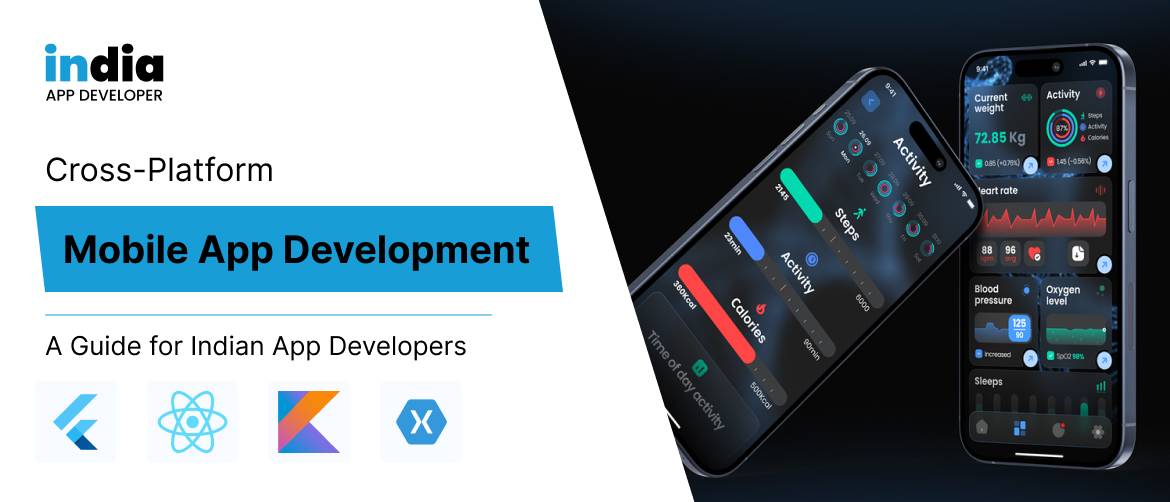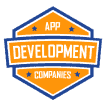Enjoy the constantly shifting environment of mobile app development and uncover the key to your company’s success. Presenting cross-platform frameworks, a game-changing option for Indian app developers (IADs). In response to demands for faster development cycles and an ever-growing user base, these frameworks are shaking up the business. This thought-provoking blog article will take you on a captivating journey through the world of cross-platform programming in the year 2024. Immerse yourself in the most recent developments, learn about the many advantages, and explore the best frameworks to elevate your next project.
The Rise of Cross-Platform App Development
Gone are the days when businesses had to build separate apps for Android and iOS. Today, cross-platform frameworks empower IADs to create a single codebase that can be deployed on multiple platforms. This translates into significant cost savings, faster development times, and wider market reach – a win-win situation for both developers and businesses.
2023: A Year of Transformation for Cross-Platform Development
The year 2023 witnessed significant advancements in the realm of cross-platform app development. Here are some key trends that have shaped the industry:
- Surge in Adoption Rates: A notable rise in cross-platform development adoption was observed, with an estimated 3% CAGR increase from 2018 to 2022, reaching a total market value of US$120 billion in 2023.
- AI and Machine Learning Integration: The integration of AI and ML technologies into cross-platform development enables the creation of smarter and more intuitive applications.
- Focus on Enhanced User Experience (UX): A heightened focus on delivering exceptional user experiences has led to an increased prioritization of UX/UI design in cross-platform app development projects.
- Optimization for 5G Technology: Strategic app optimization for 5G technology is being driven by the global transition towards faster and more reliable network infrastructures. Developers are prioritizing 5G compatibility in their projects to ensure smooth performance.
- Increased Collaboration Among Frameworks: Leading cross-platform frameworks are exhibiting increased collaboration and compatibility. Developers are leveraging multiple frameworks simultaneously to optimize app development processes.
- Shift Towards Low-Code Development: A noteworthy shift towards low-code development methodologies in cross-platform development is leading to an increase in the adoption rates of low-code platforms and tools.
These trends set the stage for an era of innovation and growth in cross-platform development in 2024 and beyond. As Indian app developers embrace these advancements, they can unlock a world of possibilities to create next-generation mobile applications.
Top Cross-Platform Frameworks to Consider in 2024
The market offers a plethora of cross-platform app development frameworks, each with its own strengths and weaknesses. Here’s a curated list of the top frameworks to consider for your project in 2024, keeping in mind the specific needs of Indian app developers:
1. Flutter
Developed by Google, Flutter is a leading cross-platform framework built on the Dart programming language. It allows IADs to build high-performance apps for six platforms – Android, iOS, desktop (Windows, Linux, macOS), web, and TV – using a single codebase.
Key Features of Flutter:
- Skia Graphics Engine: Ensures native-like app performance with smooth animations and visuals.
- Hot Reloading: Enables real-time viewing of code changes, accelerating the development process.
- Rich Widget Set: Provides a comprehensive set of widgets for both Android and iOS, allowing for the creation of native-looking UIs.
- Null Safety: Improves code stability and reduces the risk of runtime errors.
- Material Design and Cupertino Integration: Guarantees a platform-specific look and feel for a seamless user experience.
Pros of Using Flutter:
- Fast Development and Iteration: Hot reloading and a single codebase significantly reduce development time.
- Native-like Performance: Skia graphics engine delivers smooth and responsive apps.
- Declarative UI Paradigm: Simplified code structure for easier maintenance and readability.
- Large and Active Community: Extensive resources and support available for developers.
Cons of Using Flutter:
- Limited Developer Pool: Compared to React Native, the pool of experienced Flutter developers is slightly smaller.
- Larger App Size: The built-in widget set can contribute to a slightly larger app size compared to some other frameworks.
2. React Native
Since its inception in 2015 by Facebook, React Native has established itself as another frontrunner in the cross-platform development arena. This framework utilizes JavaScript (JSX) and CSS-like styling to build mobile applications that render using native platform components.
Key Features of React Native:
- Hot Reloading: Similar to Flutter, React Native offers hot reloading for rapid development cycles.
- Component-Based Architecture: Encourages code reusability and modular development.
- Large Developer Community: Benefits from a vast and active community of developers, providing ample support and resources.
- Native UI Components: Leverages platform-specific UI components for a native look and feel.
Pros of Using React Native:
- Large Talent Pool: Finding experienced React Native developers is easier due to the widespread adoption of React.
- Faster Development: Code reusability and hot reloading streamline the development process.
- Rich Ecosystem of Libraries and Tools: Extensive ecosystem of libraries and tools simplifies development tasks.
- Suitable for Complex Apps: Well-suited for building feature-rich and complex mobile applications.
Cons of Using React Native:
- Limited Access to Native Modules: Advanced features requiring native functionalities might necessitate platform-specific development.
- Debugging Challenges: Complex codebases can make debugging intricate.
3. Kotlin Multiplatform
Introduced by JetBrains in 2020, the Kotlin Multiplatform framework allows developers to share business logic code across platforms while maintaining native UI development for Android and iOS. This approach is ideal for projects that require a high degree of platform-specific customization while leveraging code reuse benefits.
Key Features of Kotlin Multiplatform:
- Shared Business Logic: Enables code sharing for core functionalities across platforms.
- Native UI Development: Maintains platform-specific UI development for optimal user experience.
- Kotlin Programming Language: Utilizes Kotlin, a modern and concise language known for its safety and readability.
- Access to Native APIs: Provides access to native APIs for leveraging platform-specific features.
Pros of Using Kotlin Multiplatform:
- 100% Native-like Apps: Enables the creation of apps with a completely native look and feel.
- Code Sharing Benefits: Reduces development time and maintenance efforts through code reuse.
- Kotlin’s Advantages: Leverages the benefits of the Kotlin programming language, such as null safety and expressiveness.
Cons of Using Kotlin Multiplatform:
- Early Stage: Still in its early stages of development, which might lead to potential limitations and a smaller community compared to established frameworks.
- Steeper Learning Curve: Requires knowledge of both Kotlin and platform-specific UI development (XML for Android and Swift for iOS).
4. Xamarin/.NET MAUI
Xamarin, an open-source framework acquired by Microsoft in 2016, has merged with .NET MAUI (Multi-platform App UI) to provide a robust development environment for cross-platform apps. Xamarin utilizes C# for code development and offers platform-specific UI creation through Xamarin.Forms.
Key Features of Xamarin/.NET MAUI:
- C# Development: Leverages C#, a popular and versatile programming language.
- Xamarin.Forms: Enables building shared UI components for a consistent look across platforms.
- Platform-Specific UIs: Allows for creating native UI experiences when needed.
- Large Developer Community: Backed by a vast Microsoft developer community.
Pros of Using Xamarin/.NET MAUI:
- Mature Framework: Benefits from the stability and extensive resources of a well-established framework.
- Large Talent Pool: Finding C# developers is relatively easy due to the language’s popularity.
- Suitable for Enterprise Apps: Well-suited for developing large-scale and complex enterprise applications.
Cons of Using Xamarin/.NET MAUI:
- Cost Factor: The enterprise edition of Xamarin can be expensive for some businesses.
- Limited Performance for Graphics-Heavy Apps: Might not be the ideal choice for apps with demanding graphics requirements.
5. Ionic
Ionic is a popular framework for building hybrid mobile apps using web technologies like HTML, CSS, and JavaScript. It leverages Apache Cordova plugins to access native device functionalities within the WebView container.
Key Features of Ionic:
- Web Technology Stack: Familiar development environment for web developers.
- Large Plugin Ecosystem: Extensive collection of plugins for integrating native functionalities.
- Rapid Prototyping: Enables quick prototyping for validating app ideas.
- Offline Support: Certain plugins allow for offline functionality within the app.
Pros of Using Ionic:
- Fast Development: Leveraging web technologies allows for rapid development cycles.
- Cost-Effective: A free and open-source framework, making it a budget-friendly option for startups and small businesses.
- Large Community and Resources: Benefits from a vast community of developers and ample learning resources.
Cons of Using Ionic:
- Limited Native Feel: Apps might not have a completely native look and feel compared to other frameworks.
- Performance Considerations: Webview container can impact performance for complex apps.
- Limited Access to Native Features: Reliance on plugins for native functionalities can introduce limitations.
Choosing the Right Cross-Platform Framework for Your Project
With a multitude of cross-platform frameworks available, selecting the most suitable option for your project requires careful consideration. Here are some key factors to ponder:
- Project Requirements: Clearly define the features, complexity, and performance needs of your app.
- Target Platforms: Identify the specific platforms (Android, iOS, etc.) you want to target.
- Development Team Expertise: Consider your team’s skills and experience with different programming languages and frameworks.
- Project Budget: Take into account the framework’s licensing costs and the potential need to hire developers with specific skillsets.
- Development Time: Evaluate the framework’s learning curve and potential impact on development timelines.
The Future of Cross-Platform Development
The landscape of cross-platform development is constantly evolving. Here are some anticipated trends that will shape the future of this domain:
- Progressive Web Apps (PWAs): PWAs are expected to gain further traction, blurring the lines between web and mobile app development.
- Advanced AI/ML Integration: Artificial intelligence and machine learning will play a more prominent role in building smarter and more intuitive cross-platform applications.
- Enhanced Security Features: Cross-platform frameworks will prioritize robust security measures to address growing security concerns.
- Cloud-Based Development: Cloud-based development environments will streamline collaboration and facilitate easier scaling of cross-platform apps.
- Focus on Developer Experience: Frameworks will continue to improve developer experience by providing more streamlined tools and functionalities.
Conclusion
Cross-platform mobile app development dallas offers a compelling solution for businesses seeking to reach wider audiences and expedite development cycles. By carefully considering your project requirements and staying updated on the latest trends, Indian app developers can leverage the power of cross-platform frameworks to build innovative and successful mobile applications.
IAD, as a leading mobile app development company in India, can assist you in navigating the cross-platform development landscape and selecting the most suitable framework for your project. Our team of experienced developers possesses the expertise to deliver high-quality cross-platform apps that meet your specific business needs.
Contact IAD today to discuss your mobile app development requirements and embark on your journey towards creating a successful mobile application!
 +1 647 637 9108
+1 647 637 9108 +1 917 477 8991
+1 917 477 8991 +61 3 9013 3988
+61 3 9013 3988 +91 93281 27044
+91 93281 27044





















